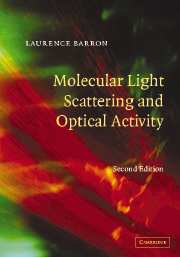Book contents
- Frontmatter
- Contents
- Preface to the first edition
- Preface to the second edition
- List of symbols
- 1 A historical review of optical activity phenomena
- 2 Molecules in electric and magnetic fields
- 3 Molecular scattering of polarized light
- 4 Symmetry and optical activity
- 5 Natural electronic optical activity
- 6 Magnetic electronic optical activity
- 7 Natural vibrational optical activity
- 8 Antisymmetric scattering and magnetic Raman optical activity
- References
- Index
Preface to the second edition
Published online by Cambridge University Press: 07 August 2009
- Frontmatter
- Contents
- Preface to the first edition
- Preface to the second edition
- List of symbols
- 1 A historical review of optical activity phenomena
- 2 Molecules in electric and magnetic fields
- 3 Molecular scattering of polarized light
- 4 Symmetry and optical activity
- 5 Natural electronic optical activity
- 6 Magnetic electronic optical activity
- 7 Natural vibrational optical activity
- 8 Antisymmetric scattering and magnetic Raman optical activity
- References
- Index
Summary
Interest in optical activity has burgeoned since the first edition of this book was published in 1982. The book anticipated a number of new developments and helped to fuel this interest, but has become increasingly hard to find since going out of print in 1990. Numerous requests about where a copy might be found, often accompanied by ‘our library copy has been stolen’ and the suggestion that a second edition would be well-received, have encouraged me to prepare this new edition. The book has been considerably revised and enlarged, but the general plan and style remain as before.
Traditionally, the field of optical activity and chirality has been largely the preserve of synthetic and structural chemistry due to the inherent chirality of many molecules, especially natural products. It has also been important in biomolecular science since proteins, nucleic acids and oligosaccharides are constructed from chiral molecular building blocks, namely the L-amino acids and the D-sugars, and the chemistry of life is exquisitely stereospecific. The field is becoming increasingly important in these traditional areas. For example, chirality and enantioselective chemistry are now central to the pharmaceutical industry since many drugs are chiral and it has been recognized that they should be manufactured as single enantiomers; and chiroptical spectroscopies are used ever more widely for studying the solution structure and behaviour of biomolecules, a subject at the forefront of biomedical science. But in recent years optical activity and chirality have also been embraced enthusiastically by several other disciplines.
- Type
- Chapter
- Information
- Molecular Light Scattering and Optical Activity , pp. xv - xviiPublisher: Cambridge University PressPrint publication year: 2004

